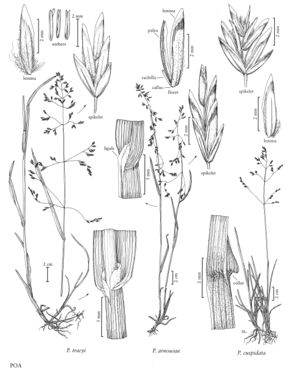Poa arnowiae
Plants perennial; loosely tufted or with solitary shoots, short-rhizomatous. Basal branching all or mostly extravaginal. Culms (15) 30-80 cm, erect or the bases decumbent, terete or weakly compressed; nodes terete, 1-3 exserted. Sheaths closed for 1/2 - 9/10 their length, compressed, smooth, glabrous, bases of basal sheaths glabrous, distal sheath lengths 1-3 times blade lengths; collars smooth, glabrous; ligules 0.5-4 mm, smooth or sparsely scabrous, truncate to obtuse; innovation blades similar to the cauline blades; cauline blades 2-5 mm wide, flat, thin, smooth or sparsely scabrous mainly over the veins, apices broadly prow-shaped, middle and upper cauline blades subequal in length, flag leaf-blades (2.5) 4-7 (11) cm long. Panicles (5) 12-22 cm, usually narrowly pyramidal, open, sparse, with 20-70 spikelets, proximal internodes usually (3.5) 4+ cm, with 2-3 (4) branches per node; branches 3-8 cm, spreading to eventually reflexed, terete or weakly angled, sparsely to moderately scabrous, with 3-12 spikelets. Spikelets 5-9 mm, lengths to 3.5 times widths, laterally compressed, not sexually dimorphic; florets 2-6; rachilla internodes smooth, glabrous, distal internodes 1+ mm. Glumes lanceolate, distinctly keeled; lower glumes 1-3-veined; calluses glabrous; lemmas 3-6.5 mm, lanceolate, distinctly keeled, keels and marginal veins glabrous or short-villous to softly puberulent to 1/3 their length, lateral-veins obscure, intercostal regions glabrous or sparsely hispidulous, rarely softly puberulent, smooth or sparsely finely scabrous, margins glabrous, apices acute; palea keels scabrous, glabrous, intercostal regions glabrous; anthers vestigial (0.1-0.2 mm) or (1.3) 2-3.6 mm. 2n = unknown.
Distribution
Mont., Wyo., Idaho, Utah
Discussion
Poa arnowiae grows in openings within the coniferous forests of the mountain ranges in southeastern Idaho, northern Utah, and adjacent Wyoming. It is sequentially gynomonoecious.
Poa arnowiae used to be called Poa curta Rydb., but the type of P. curta belongs in P. wheeleri.
Selected References
None.
Lower Taxa
"thin" is not a number.No values specified."decumbent" is not a number.
